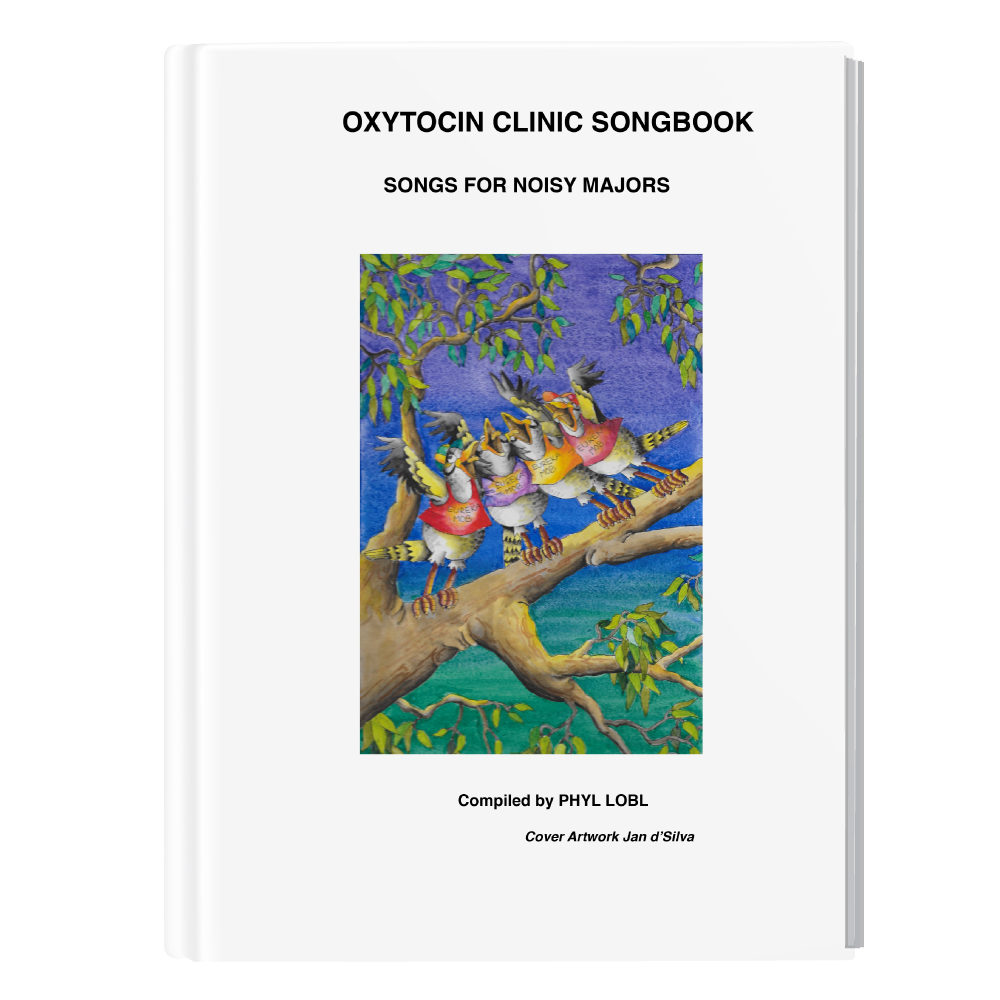Oxytocin Clinic Songbook
SONGS FOR NOISY MAJORS
‘Songs for Noisy Minors’ is a book in the NOT JUST NOISE QUEST also on this site.
Compiled by PHYL LOBL
Cover Artwork Jan d’Silva
Purpose of this site
More often than not people find the action of singing gives a positive experience.
The release of the hormone Oxytocin is given much credit for this feeling.
This collection is compiled with the hope that people will find their voices and some fun and some connection through these songs.
NB.Oxytocin not to be confused with Oxycontin.
Oxytocin is a powerful hormone that acts as a neurotransmitter in the brain. It regulates social interaction and plays a role in behaviours in regard to empathy, generosity, and co-operation. It is a hormone that underlies trust and is also an antidote to depressive feelings. It is released in humans when involved in making music or engaged in activities which require co-operation and is similar to a hormone released in song birds.
Not to be confused with: OxyContin,a prescription, morphine-like narcotic intended to relieve pain.It is a dangerous drug and called Oxy in the street.
This collection of Lyrics, given with a site for the tune on Utube creates the possibility that people can use the song collection to learn or teach songs around their kitchen table and become KITCHEN TABLE SINGERS.

One of the Hallmarks of Folk Music is that variations do happen, and generations of singers have altered both words and tunes along a song’s journey into Folklore/Folk Music. Sometimes this happens through ‘misremembering’, sometimes to add clarity of meaning or historical truth, sometimes to add a higher level of ‘musicality’.
Notation can only be used by people who are musically literate. Many fine singers are not musically literate but can offer fine interpretation using aural skills.
As a singer I prefer the words I have printed but I have not recorded my version, so in order to relay the tune to potential KITCHEN TABLE SINGERS I have supplied a UTube Link in order that people can learn the tune aurally. They can choose which words they would rather sing.
FOR PEOPLE WHO EXPERIENCE DIFFICULTY IN MAINTAINING PITCH
Some people who have been told they are tone-deaf are not often ‘tone-deaf’ at all, they just have not learned to listen to themselves. This can be because they listen to songs through earphones, sing with the recorded voice and what they hear is that recorded voice rather than their own.
Control of pitch is primarily a muscular control. Its mastery is a question of training, as in athletic training.
The Auditory Cortex is a part of the brain and just as the body muscles require constant use so to do the muscles of the Auditory Cortex.
Singing in tune involves three steps: to hear, to remember, to reproduce.
STEPS TO LEARNING TUNES FROM A RECORDED VOICE
1. Just listen to the track at least 3 times. Let the tune resonate in your head.
Try to ‘hear’ the tune with your ‘inner ear’ without the song playing.
2. Listen and just ‘lip’ the words without creating any sound. Say the words silently.
3. Listen to the song in short pieces, phrases or lines of song.
Stop the sound and echo the lines with HUMMING of the tune.
Open the throat and sing the tune to Ahhhh.
Add the words.
If the song has a chorus listen to the song but only sing the chorus.
Build up to sing with the verses when you feel confident that you can pitch the tune.
Using an electronic tuner that responds to voice will show you if you are on pitch.
If you have the facility on computer or phone to record your voice check if you are on pitch from that.
Try this on-line voice recorder
ALSO NOTE
Before singing sessions drink water and clear nasal passages.
EXERCISES FOR SINGERS
BREATHING
1. Breathe in,COUNT to 10 as many times as possible until you have to breathe. Use fingers to indicate total of 10’s. Aim for increasing number of 10’s but beware of overdoing it you could become faint then fainter, then fainter. then fainter
2. Lie on floor. Lift & lower diaphragm muscles to feel the action. Put hand on diaphragm breathe in and lift hand with breath.
VOICE
1.Still on back on floor open throat and ’ huff ‘the air onto the roof of your mouth.
Now sing ahhhhhhhhhhhhh consciously feeling your throat is wide open. Shout at the roof.
2. Standing up Singing ing ing ing ing ing ingahhhhhhhhhh
Songong ong ong ong ong ongahhhhhhhhhh
Sungung ung ung ung ung ungahhhhhhhhhh
Same exercise with different pitches some higher some lower.
3. Hum the Ear Training Songs
4. Hum a Major Scale. (doh ray me fah soh lah te doh)
Change the Starting Note.
5. Sing the main tones of a major scale
TONIC = doh THIRD scale note= me FIFTH scale note = soh Upper TONIC doh’
Going up and then back down
doh me soh doh‘ soh me doh
Change the Starting Note to higher and to lower pitches
Get a copy of the Oxytocin Clinic Songbook

